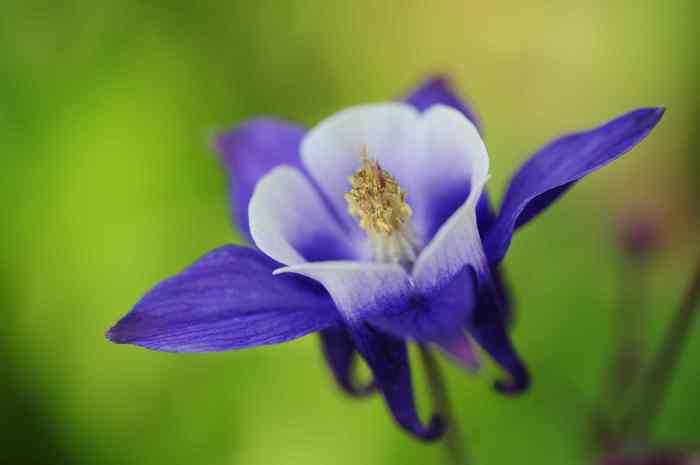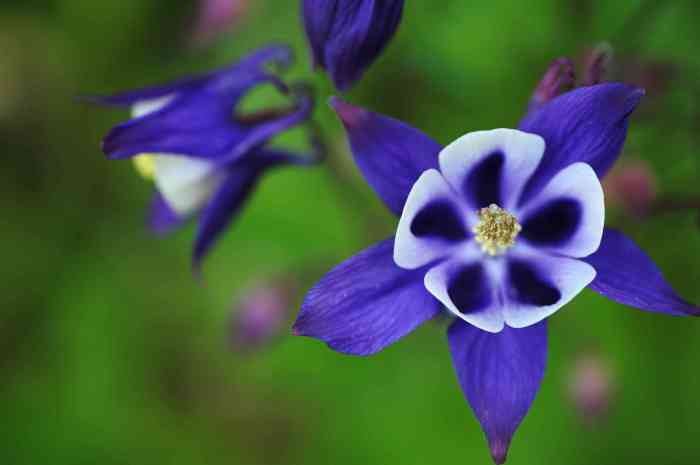Preparing the Planting Site

How to plant columbine flowers – So, you’re ready to unleash the vibrant beauty of columbines upon your garden? Fantastic! But before you get your trowel twitching, let’s talk about giving those little beauties the best possible start in life. Think of it as creating a five-star hotel for your future floral friends. No cramped, weedy hovels for these divas!Preparing the soil is crucial; it’s like setting the stage for a magnificent columbine performance.
Poor soil equals a wilted, underwhelming show. We want a standing ovation, people! This involves a bit of detective work, some muscle (or a very helpful friend with a strong back), and a dash of horticultural know-how.
Soil Preparation and Drainage
First, let’s get to know your soil. A simple soil test kit (available at most garden centers) will reveal its pH level and nutrient content. Columbines prefer slightly acidic to neutral soil (pH 6.0-7.0). If your soil is too alkaline, you can amend it with peat moss or sulfur. If it’s too acidic, lime is your friend.
Think of it as a soil spa day – pampering it to perfection! Next, good drainage is key. Columbines hate soggy feet. If your soil is heavy clay, which retains water like a sponge, you’ll need to improve drainage. This can be done by adding organic matter like compost or well-rotted manure to improve soil structure and aeration.
Imagine adding fluffy clouds of goodness to your dense clay!
Creating Raised Beds for Optimal Growth
For particularly poorly draining soil, creating a raised bed is a game-changer. Picture this: a glorious mound of soil, elevated above the surrounding ground, providing excellent drainage and warmth. You can build a raised bed using readily available materials like wood, stone, or even recycled plastic. Fill it with a well-draining mix of garden soil, compost, and perhaps some perlite for extra aeration.
It’s like giving your columbines their own private, well-ventilated penthouse suite.
Weed Control: The Enemy of Happy Columbines
Finally, before planting, wage war on weeds! These pesky plants compete with your columbines for water and nutrients. A thorough weeding before planting is essential. Think of it as clearing the stage for your columbines’ grand entrance. No unwanted actors stealing the spotlight! Remove all existing weeds, including their roots, to prevent future problems. You might even consider using a pre-emergent herbicide (carefully following label instructions) to prevent weed seeds from germinating.
A weed-free environment allows your columbines to thrive, ensuring they reach their full potential. It’s like giving them a clean, uncluttered dressing room before their big performance.
Planting Columbine Seeds or Seedlings
So, you’ve got your perfectly prepped planting site – congratulations, you’re halfway to a columbine wonderland! Now comes the fun part: actually getting those little beauties in the ground (or, initially, in a pot). Let’s dive into the delightful world of columbine propagation. Think of it as a tiny, floral version of Operation: Get the Seeds in the Soil.Starting columbine seeds indoors offers a head start, especially if you live in a climate with a shorter growing season.
Yo, planting columbines is low-key easy. Just dig a hole, pop the little dude in, and water it. But for some extra oomph, check out this link for plant food for flowering plants – seriously boosts those blooms! After you feed them, make sure to keep the soil moist, and before you know it, you’ll have a killer columbine garden, dude.
It’s like giving your columbines a tiny, cozy apartment before they move into their dream house (your garden). This method allows for more control over the environment, increasing your chances of success, and ensuring those precious little seedlings don’t get eaten by mischievous garden gnomes (or, you know, slugs).
Starting Columbine Seeds Indoors
Sowing columbine seeds is a surprisingly straightforward affair. Simply sprinkle the seeds thinly onto a well-draining seed-starting mix. Don’t bury them too deep; a light dusting of soil is all they need. Columbines prefer a cool environment; aim for temperatures around 65-70°F (18-21°C). Too hot, and they’ll think they’re on a tropical vacation and refuse to germinate.
Imagine a tiny columbine shouting, “This is NOT my ideal climate!”Adequate light is crucial. A sunny windowsill works well, but you may need to supplement with grow lights, especially during shorter days. Think of it as giving your seeds a daily dose of vitamin D, but for plants. Keep the soil consistently moist but not soggy. Overwatering is a common mistake; it’s better to underwater slightly than to drown your tiny charges.
Planting Columbine Seedlings or Transplants Outdoors
Once your seedlings have a few true leaves (the leaves that look different from the seed leaves), it’s time for the great outdoors! Space your columbines about 12-18 inches apart. This gives them enough room to grow without feeling cramped and competing for resources. Planting depth should be the same as they were in their pots – don’t bury them any deeper! Think of it like giving them a comfy, perfectly sized bed.
Watering Newly Planted Columbines
Water deeply and thoroughly after planting, ensuring the soil is moist but not waterlogged. Consistent moisture is key, especially during the establishment phase. But don’t overdo it! Overwatering can lead to root rot, which is about as fun as a root canal. Aim for regular watering, but allow the top inch or so of soil to dry out between waterings.
It’s a delicate dance – you want to keep them happy, but not spoil them rotten!
Propagating Columbines: How To Plant Columbine Flowers

So, you’ve successfully planted your columbines, and now you’re thinking, “How can I get more of these delightful, dangling beauties without spending a fortune on more seeds?” Fear not, fellow plant enthusiast! Propagating columbines is surprisingly straightforward, and we’re about to delve into the wonderfully weird world of columbine reproduction. Prepare for a horticultural adventure filled with more twists and turns than a particularly enthusiastic vine!
Seed Saving
Saving columbine seeds is like winning a tiny, floral lottery. It’s a gamble, but the potential payoff—free columbines!—is too tempting to resist. The success rate varies wildly depending on the weather, your seed-saving technique (more on that later!), and whether or not a rogue squirrel decided your seed pods were a particularly delicious snack. However, if you’re patient and a little bit lucky, you can end up with a whole bunch of new columbines that might even sport unique characteristics thanks to the magic of cross-pollination (or, you know, a squirrel’s random pollen-spreading activities).
To save seeds, let the seed pods mature fully on the plant until they turn brown and papery. This usually happens in late summer or early fall. Gently collect the pods, and let them dry completely in a cool, dry place. Once dry, carefully crack open the pods and extract the tiny, black seeds. Store them in a cool, dark, dry place in an airtight container until spring planting.
Remember, those seeds are precious cargo! Think of them as miniature, floral Fabergé eggs.
Division
Dividing columbines is like splitting a really stubborn, but ultimately rewarding, personality. It’s a less risky method than seed saving, offering a higher success rate and quicker results. Columbines often self-seed, creating a cluster of plants that can be easily divided. This method is best done in early spring or fall when the soil is moist and the plants are actively growing or preparing for dormancy.
To divide, carefully dig up the clump of columbines, gently separating the roots into smaller sections, each with several healthy stems and roots. Replant these divisions immediately, ensuring each has enough space to grow. Think of it as a gentle game of floral Jenga, but with way less risk of catastrophic collapse (unless you’re particularly clumsy with a trowel).
Cuttings, How to plant columbine flowers
Propagating columbines from cuttings is the most challenging method, akin to performing floral brain surgery. Success rates are lower than seed saving or division, but the thrill of the challenge might just be worth it for the determined gardener. This method involves taking stem cuttings from healthy, actively growing plants in spring or early summer. The cuttings need to be treated with rooting hormone and planted in a moist, well-draining medium.
Keep them consistently moist and in bright, indirect light until roots develop, which can take several weeks. Imagine it as a floral David and Goliath story—a tiny cutting battling the odds to become a magnificent columbine.
While all three methods have their quirks, remember that patience and a dash of horticultural humor are key to successful columbine propagation. Happy growing!
Illustrative Examples of Mature Columbine Plants

Let’s get down to the nitty-gritty and admire some mature columbine specimens, shall we? These aren’t your average, run-of-the-mill garden plants; these are the rock stars of the columbine world. Prepare to be amazed (and maybe a little bit jealous).Columbines, in their mature glory, are a sight to behold. Their delicate beauty belies a surprisingly hardy nature. Their size, shape, and color vary widely depending on the cultivar, creating a diverse tapestry of floral delights.
Let’s look at three examples to illustrate this stunning diversity.
Columbine ‘McKana’ Giants
Imagine a columbine that practically screams “look at me!” The ‘McKana’ Giants are just that – giants amongst columbines. These beauties can reach heights of up to 3 feet, their sturdy stems adorned with abundant, large, saucer-shaped blooms. The flowers themselves are a breathtaking mix of vibrant colors; think deep crimson petals delicately tipped with a creamy yellow, almost like a flamboyant sunset.
The foliage is a lush, ferny green, providing a striking contrast to the vibrant flowers. Picture these majestic plants thriving in a slightly shaded border, nestled amongst other perennials, their airy presence adding a touch of elegance to a cottage garden setting. The rich soil and consistently moist (but not soggy!) conditions help them reach their full, glorious potential.
They’re the kind of plant that makes you want to throw a garden party just so you can show them off.
Columbine ‘Winky’ Double
Now, for something a little different. The ‘Winky’ Double columbine is a compact variety, reaching a more manageable height of around 18 inches. But don’t let its size fool you; it packs a serious floral punch. These columbines boast fully double flowers, meaning each bloom is bursting with twice the usual number of petals. The color is a soft, pastel pink, almost blushing, with a delicate hint of lavender.
The foliage is a finely textured, silvery-green, adding a subtle textural element to the overall appearance. Imagine these charming plants cascading down a rockery or spilling over a low wall, their delicate blooms creating a cloud of pink in a sunny spot. Well-drained soil is key for these delightful little plants, as they’re less tolerant of soggy conditions than their taller cousins.
Columbine ‘Clementine’
If you’re a fan of bold statements, the ‘Clementine’ columbine is your match. This variety is known for its intensely orange-red flowers, a truly fiery spectacle. They stand tall, reaching approximately 2 feet, their stems adorned with gracefully nodding blooms. The petals are a rich, almost incandescent orange-red, beautifully offset by the dark, almost purplish foliage. Picture these vibrant plants thriving in a mixed border, their bold color providing a focal point amongst other plants with softer hues.
They enjoy a slightly acidic soil and partial shade, making them perfect for a woodland garden setting. These are the kind of columbines that demand attention – they’re the life of the garden party, not just an attendee.
Visual Description of a Columbine in Full Bloom
Envision a single columbine flower, its five sepals gracefully arching backward to reveal a crown of five inner petals, each spurred at the base, resembling tiny dangling bells. These spurs, often a contrasting color, are filled with nectar, attracting hummingbirds and butterflies. The delicate petals, perhaps a soft lavender, are intricately veined with deeper purple lines, adding a subtle touch of complexity to the overall design.
The foliage is a vibrant, finely divided green, resembling delicate ferns, forming a backdrop that beautifully showcases the vibrant blooms. The entire plant, perhaps a foot tall, stands proudly, a testament to the exquisite beauty of nature’s design. The scene is bathed in soft sunlight, highlighting the delicate texture and vibrant colors of this stunning bloom. It’s a picture postcard moment, capturing the essence of springtime beauty.
Helpful Answers
What is the best time of year to plant columbines?
The best time to plant columbines is in spring or fall, after the last frost.
How often should I water my columbines?
Water regularly, especially during dry spells, but avoid overwatering, which can lead to root rot.
Can columbines be grown in containers?
Yes, columbines can be grown in containers, provided they have well-draining soil and sufficient space.
What should I do if my columbines are not flowering?
Lack of flowering can be due to insufficient sunlight, poor soil conditions, or overcrowding. Check these factors and adjust accordingly.





